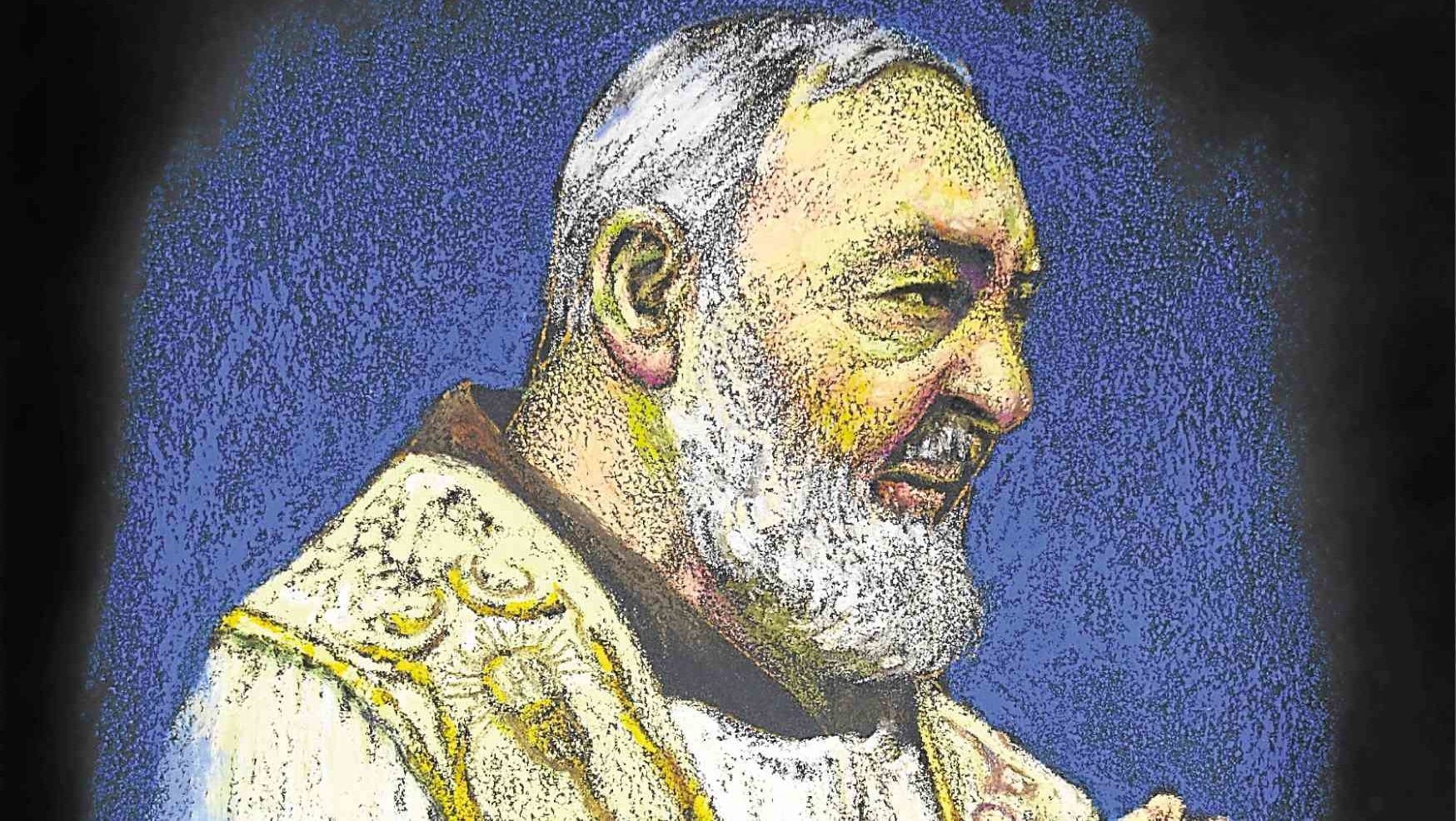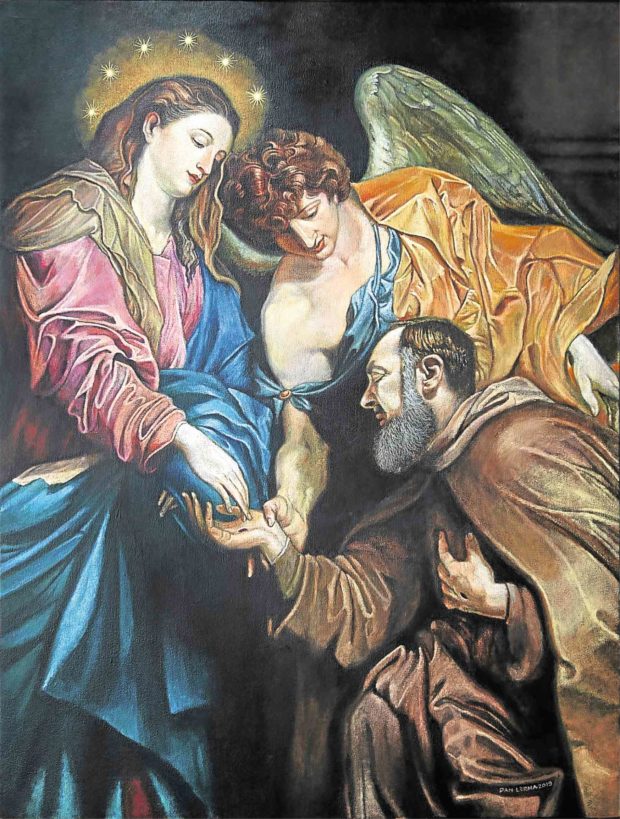
Physicians in the Philippines have lately composed the growing army of art collectors that has made the Philippines a vibrant market for contemporary art in the region. But not quite known is that some physicians have excelled in art. Mostly self-trained, they could give the academically trained artists a run for their money. To this motley group belongs Dr. Dante “Dan” Lerma of the University of Santo Tomas (UST) Health Service.
Lerma has been generating buzz for some years now owing to his paintings of mainly religious subjects that disclose the influence of Renaissance and Baroque masters. His realistic figuration of angels, doves, the Virgin Mary and the saints, and even the Crucified Christ, draw as much from the tradition of Latin Christian iconography as from Grey’s Anatomy.
Now comes “Pio et Maria (Pius and Mary),” his second solo exhibit opening Oct. 18 at the UST Museum of Arts and Sciences. The iconography seems more developed: Dan Lerma’s is art that combines spirituality and therapy, piety and healing. It is wholistic art, if there was one.
Curated by UST fine arts faculty Mary Ann Venturina-Bulanadi and artist Wilfredo Offemaria Jr., “Pio et Maria” consists of a series of portraits of Saint Pius of Pietrelcina (1887-1968), the Italian Franciscan Capuchin more popularly known as Padre Pio. Perhaps the 20th century’s most famous saint, the friar-priest was and remains best-known as a miracle worker. He reportedly bore the wounds of Christ on the cross.
Then as now, Padre Pio is able to heal the sick, read minds, levitate, bilocate, make prophecies and drive out demons, which, according to the Gospel of Luke (11:20), is a sign of God’s favor and coming: “But if it is through the finger of God that I cast out devils,” Christ said, “then know that the Kingdom of God has overtaken you.”
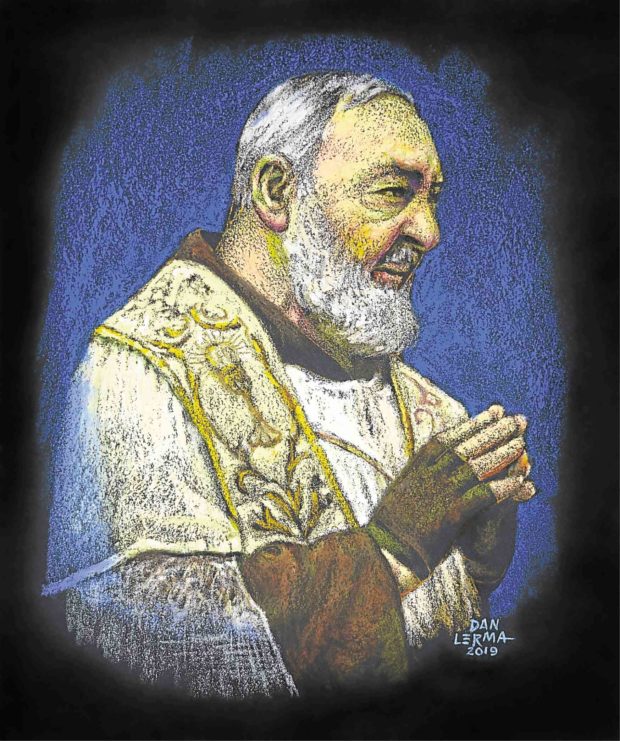
In the exhibit, each portrait (oil pastel on sandpaper, 28 x 23 centimeters) shows Padre Pio in the attitude of prayer and reflection. The portraits are Marian-inspired and in the exhibit, each work comes with an acclamation or exhortation by Padre Pio of the glories of the Blessed Mother.
In “My Mother, My All,” which shows the stigmatist in the ordinary brown habit of his mendicant friar order, Padre Pio is quoted saluting the Virgin: “The Mother of Sorrows is my confidante, my teacher, my counselor, and my powerful advocate.”
In “A Heart Aflame,” showing Padre Pio gazing heavenward, he is quoted as having “entrusted” to her “the painful anxieties of my heart” and how she had always “consoled me.” In the portrait, he wears the priest’s robes and the “anxieties” obviously referred to the physical pain of reliving the sacrifice of the Christ on the altar because of the stigmata as well as the embarrassment his wounds were causing him because of the ridicule and suspicion heaped on him by cynics and detractors even from ecclesiastical circles.
Gratitude
The portraits should show Doc Dan Lerma’s devotion to the Capuchin saint. In 2008, he made his first portrait of the saint, an acrylic-on-canvas, as a gift to an uncle who was an avid devotee of the saint and ordained a lay deacon in New York that year. Through the years, Lerma did other portraits of Padre Pio as “gifts for friends who I believed were in dire need of healing, physically and spiritually.”
This 2019, he did the Padre Pio portraits for the exhibit between January and April, hoping them to be shown to commemorate the solemnity of the saint on Sept. 23, but as it turns out, the exhibit has been moved to October this month, when the Solemnity of Our Lady of the Rosary is celebrated.
The portraits were done to manifest “sincere gratitude for the saint’s powerful intercession, which I badly needed,” Lerma said. Looking back, even the portraits of the saint he did for friends contributed to his own healing. “To be able to uplift someone, to be able to offer even just a flicker of hope for people in need through these portraits , for me, is also … healing oneself,” he said.
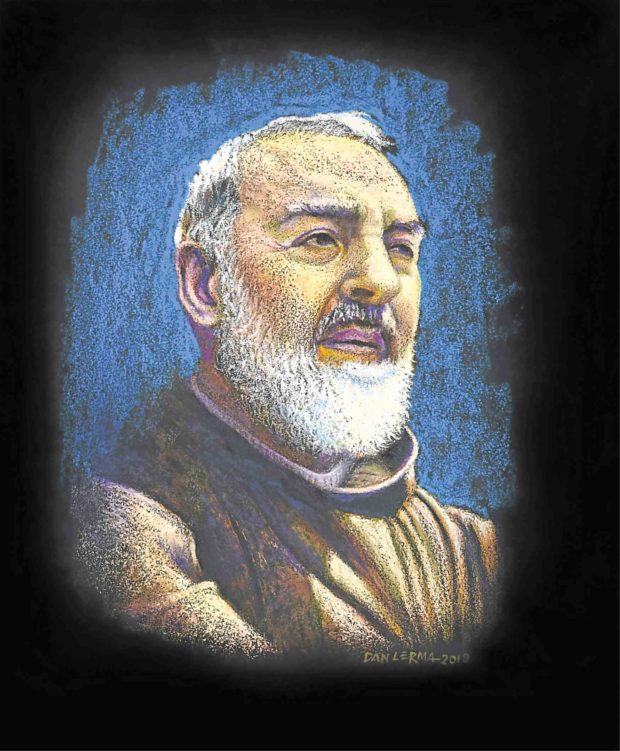
But why portraiture? “For me, portraiture would be the best way to pay homage to someone whom you deeply respect and believe in. To be able to capture one’s countenance the best way you can is to be able to tell his/her story in a very unique yet personal manner.”
‘Totus Tuus’
Centerpiece of the exhibit is a large work, “Totus Tuus,” showing Padre Pio with his guardian angel presenting his wounds to the Blessed Mother for comfort and consolation.
“Totus Tuus,” according to Lerma, was inspired by “The Vision of the Blessed Hermann Joseph, or The Mystical Engagement of the Blessed Hermann Joseph to the Virgin Mary,” by the Flemish Baroque painter Anthony van Dyck (1599-1641). In itself Van Dyck’s painting, according to art historians, may have been influenced by “The Vision of Saint Francis Xavier” by another Antwerp painter Gerard Seghers (1591-1651), and both painters were influenced by “Saint Teresa of Avila’s Vision of the Holy Spirit” by the Flemish master Peter Paul Rubens (1577-1640).
In fact the tradition of depicting the mystical marriage between saint and the Blessed Mother or Christ has had a long history. One would find late medieval depictions of the High Middle Ages Dominican Saint Catherine of Siena and her mystical marriage to Christ, for example, clearly referring to the invisible stigmata she was said to have received from the Lord himself.
But Lerma’s “Totus Tuus” clearly owes its inspiration from the Baroque tradition fostered by Rubens, Velasquez, Caravaggio during the Counter-Reformation against the Protestants.
Since Protestants attacked Mary and the saints, Counter-Reformation art, according to the Council of Trent (1545-1563) should focus on them and depict their innocence, kindness and mourning for Christ. There should be no misunderstanding that the cult of Mary and the saints constituted the worship meant only for Jesus Christ; theirs would be a form of veneration meant for the select whose intercession would be needed to get closer to Christ.
“Totus Tuus” bears the hallmarks of Lerma’s devotion to Baroque realism: clear but striking composition, highly dramatic figuration and chromatic richness.
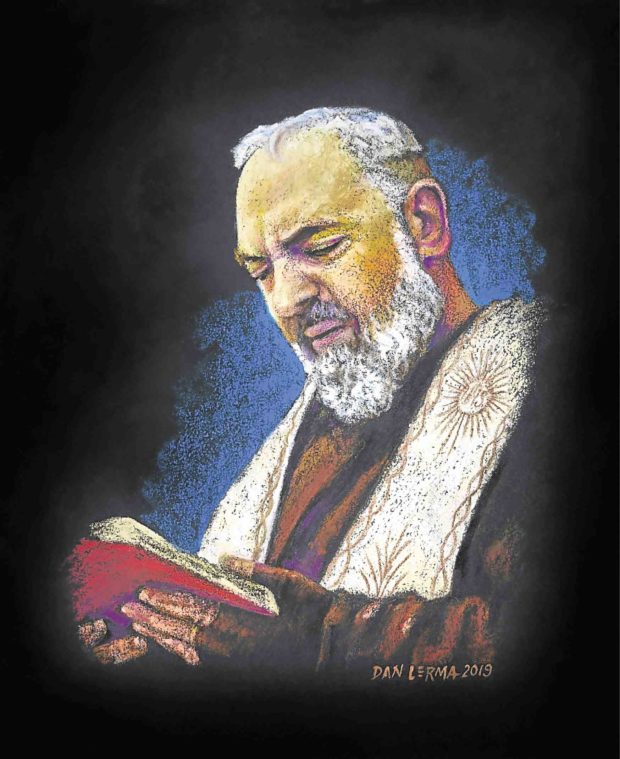
Clearly this picture is set against the world’s doubt and ridicule of the stigmata, the doubt that had been evinced by no less than the apostle Thomas Didymus (“The Twin”), or the Doubting Thomas, who refused to believe that Christ had resurrected and declared, “Unless I see the holes that the nails made in his hands and can put my finger in the holes they made, and unless I can put my hand into his side, I refuse to believe” (John 20:25).
The Latin title of Lerma’s centerpiece means “totally yours,” the motto of Pope, now Saint, John Paul II, who as a young priest after the war had met the Capuchin friar. It was to him that the Capuchin revealed which of his wounds was the most painful: “It is my shoulder wound, which no one knows about and has never been cured or treated.”
Despite the pain, Padre Pio courageously carried on because of the consolation he received from the Madonna.
Now as then, Padre Pio continues to be a sign of contradiction in a world where faith is wanting and doubt seems the order of the day. But for those who have been healed and blessed through the intercession of this simple Capuchin friar bearing the mystical wounds of the passion of Christ, and suffering as a result the ignominy and ridicule of a severely cynical world, there’s not a shred of doubt that the finger of God is in here.
Dante Lerma’s “Pio et Maria” will run at the UST Museum of Arts and Sciences on Oct. 18 to Nov. 15, 2019.
Museum hours: Monday, 1-5 p.m.; Tuesday to Saturday, 8:30 a.m. to 5 p.m.

